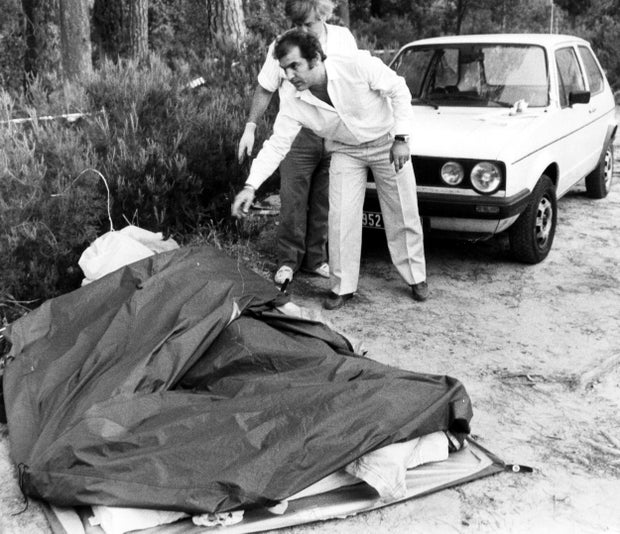Newly found DNA could shed light on "Monster of Florence" serial killer case decades after mysterious murders of couples
Newly discovered DNA could shed light on one of Italy's most famous cold cases, finally revealing the "Monster of Florence" serial killer who murdered young couples in the 1970s and 80s.
More than half a century since the first shocking murders sowed terror in Tuscany, doubt over the murderer or murderers continues to cloud the case, even though three different men have been convicted and sent to prison over the years for some of the 14 or more murders.
But some are still unaccounted for and many questions remain.
Now, a new scientific finding has given hope to some of the victims' families, even while experts advise caution.
A prominent Italian doctor practicing oncology and hematology in the United States, Lorenzo Iovino, recently studied earlier analyses of DNA samples from a .22 caliber Winchester bullet found in 2015 in a cushion belonging to Nadine Mauriot and Jean-Michel Kraveichvili, a French couple shot dead in their camping tent in 1985.
That same DNA was taken from similar bullets found after the September 1983 murder of two German university students, Horst Wilhelm Meyer and Jens-Uwe Rusch, who investigators believed were probably mistaken for a couple -- and the murder of Italians Pia Rontini and Claudio Stefanacci in July 1984.
The DNA could prove to be "very important," Daniele Piccione, a lawyer who chaired a parliamentary inquiry commission into an unsolved aspect of the case that ended in 2022, told AFP.
Murder weapon never found
The "monster" or "monsters" of Florence terrorized the capital of Tuscany and its countryside between 1974 and 1985 by murdering 14 people, including six couples, most of whom were shot in their cars during or immediately following sexual intercourse.
Italy was then going through a bloody period of political violence dubbed the "Years of Lead," in which the Red Brigades and armed groups of the extreme right, together with mafia violence, caused thousands of deaths.
The murder weapon in the cold case -- a Beretta semi-automatic pistol -- has never been found. Often, the assassin stabbed his victims after death, committing atrocious sexual mutilations on the corpses of the young women.
The sprawling case was hindered by competition between two investigating authorities -- the regular police and the carabinieri force -- as well as between prosecutors and judges.
Investigators followed multiple leads, from a Sardinian vendetta to the Italian secret services, from a sect to a conspiracy of notables.
Finally, a poor farmer portrayed as violent and sex-obsessed by prosecutors, Pietro Pacciani -- already convicted of homicide in 1951 and imprisoned in 1987 for raping his two daughters -- was sentenced to life in 1994.
Pacciani, who called himself "innocent as Christ on the cross", was acquitted on appeal two years later, but he was awaiting retrial when he died in 1998 of a heart attack at the age of 73.
Two of Pacciani's alleged accomplices, Mario Vanni and Giancarlo Lotti, were also found guilty and sent behind bars. Both have since died.
In 2007, an FBI profile of the serial killer said the murderer acted alone, according to NBC News.
"She could have fought with the assassin"
Lawyers for the civil parties in the case are now asking for the DNA identified by Iovino to be compared.
But with whose?
Vieri Adriani, a lawyer for the families of the French victims, wants the body of Italian victim Stefania Pettini, murdered in September 1974 with her boyfriend Pasquale Gentilcore, to be exhumed.
"We know, according to the medical examiner's report, that she could have fought with the assassin, and it's not impossible to imagine that there remained biological traces, under her fingernails, for example," he told La Repubblica daily this week, confirming his comments to AFP.
Under the same logic, DNA could also be taken from Gentilcore's clothing.
According to Iovino, the new DNA does not match that of the victims nor with anyone convicted over the decades.
For Roberto Taddeo, a former lawyer and author of a compendium on "the Monster of Florence", the new DNA could be due to contamination by investigators, technicians or forensic scientists who worked on the case.
Taddeo recommended "the greatest caution," warning against falling into judicial "revisionism."
"Pacciani did not die innocent in the eyes of Italian law, he died before his new trial," he told AFP.
A first murder sometimes attributed to the elusive killer or killers dates back to 1968, when a woman and her lover were murdered during their clandestine lovemaking in a car.
The deceived husband was convicted. Years later, investigators discovered that the murder weapon was the famous Beretta from the "Monster of Florence" killings.
Did the weapon change hands? Did an innocent man pay for the guilty one?
The early double homicide remains one of the many mysteries of the case.
Filmmakers and authors cover infamous case
The infamous case is the basis of a Netflix drama called "Il Mostro," which is based on court testimony, legal documents and reporters' investigations.
"Telling the truth, and only that, is the only way to bring justice to the victims," director Stefano Sollima told The Hollywood Reporter earlier this year.
In 2021, Deadline reported that Antonio Banderas had been cast to play Italian crime reporter Mario Spezi in a series called "The Monster of Florence," based on the book by Spezi and American novelist Douglas Preston. In the book, the authors uncovered a series of alleged mistakes made by police during their investigation of the murders.
Spezi was arrested in 2006 by authorities in a probe that also entangled Preston, the Associated Press reported. Prosecutors accused the journalist of slander and of sidetracking their investigation into the "Monster of Florence" murders.






